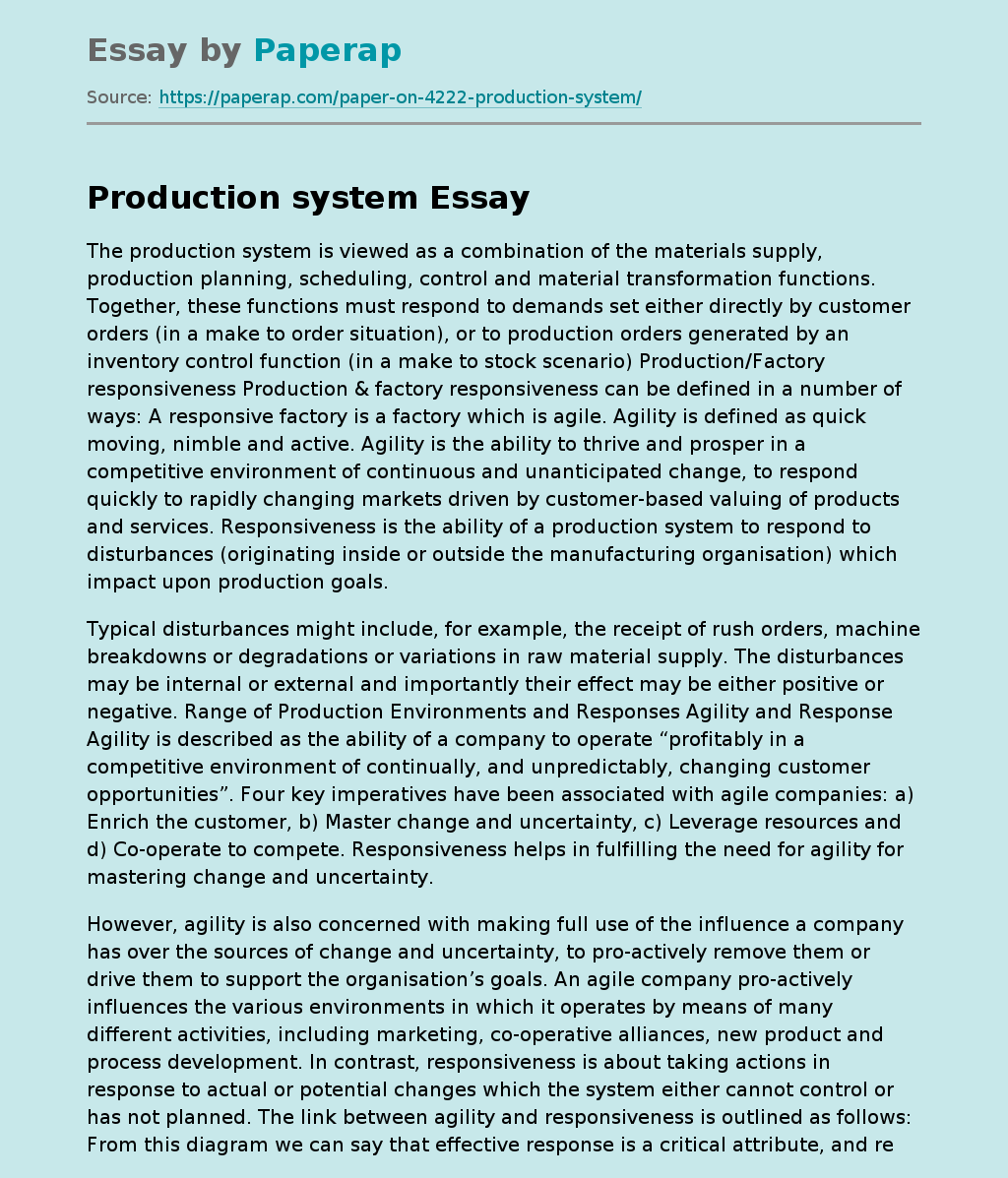Production system
The production system is viewed as a combination of the materials supply, production planning, scheduling, control and material transformation functions. Together, these functions must respond to demands set either directly by customer orders (in a make to order situation), or to production orders generated by an inventory control function (in a make to stock scenario) Production/Factory responsiveness Production & factory responsiveness can be defined in a number of ways: A responsive factory is a factory which is agile. Agility is defined as quick moving, nimble and active.
Agility is the ability to thrive and prosper in a competitive environment of continuous and unanticipated change, to respond quickly to rapidly changing markets driven by customer-based valuing of products and services. Responsiveness is the ability of a production system to respond to disturbances (originating inside or outside the manufacturing organisation) which impact upon production goals.
Typical disturbances might include, for example, the receipt of rush orders, machine breakdowns or degradations or variations in raw material supply.
The disturbances may be internal or external and importantly their effect may be either positive or negative. Range of Production Environments and Responses Agility and Response Agility is described as the ability of a company to operate “profitably in a competitive environment of continually, and unpredictably, changing customer opportunities”. Four key imperatives have been associated with agile companies: a) Enrich the customer, b) Master change and uncertainty, c) Leverage resources and d) Co-operate to compete. Responsiveness helps in fulfilling the need for agility for mastering change and uncertainty.
However, agility is also concerned with making full use of the influence a company has over the sources of change and uncertainty, to pro-actively remove them or drive them to support the organisation’s goals. An agile company pro-actively influences the various environments in which it operates by means of many different activities, including marketing, co-operative alliances, new product and process development. In contrast, responsiveness is about taking actions in response to actual or potential changes which the system either cannot control or has not planned. The link between agility and responsiveness is outlined as follows: From this diagram we can say that effective response is a critical attribute, and represents the reactive capabilities of an agile organization. Another important parameter to be considered over here is system flexibility.
System Flexibility has received much attention as a manufacturing research topic in the last decade or so. It is the ability of a production system to change the mix, volume and timing of its outputs. Total system flexibility is a complicated function of many system attributes, including machine and subsystem flexibilities. While system flexibility constitutes a possible means for responding to disturbances (both internal – e.g. machine breakdowns – and external – e.g.
demand variation, rush-orders) it is not synonymous with responsiveness, since the system must also be able to judiciously use its flexibility in response to disturbances – i.e. decide when to flex its outputs and by how much. Parameters to measure factory responsiveness We feel that factory responsiveness cannot be determined by a single variable. In fact, In order to improve factory responsiveness, first it is necessary to find those variables which would help us to measure & quantify factory responsiveness. This will also help us to fix suitable benchmarks.
Also, ignoring the factory, will only lead to increased inventory, longer cycle times, and higher costs as product variety increases. There are a number of compelling reasons why the factory should be the starting point in the journey toward demand driven manufacturing. First, converting to lean manufacturing in the factories will help ensure that ERP software is not merely automating an otherwise bad process. Secondly, the factory is often the starting point for companies intending to make broader supply chain improvements. When a company sees significant results from the lean manufacturing transformation, they can often convince suppliers to do the same, providing help and experience.
Once the factory is lean, upstream supply chain improvements help ensure that supply disruptions do not hamper the lean factory.
Production system. (2017, Aug 31). Retrieved from https://paperap.com/paper-on-4222-production-system/

